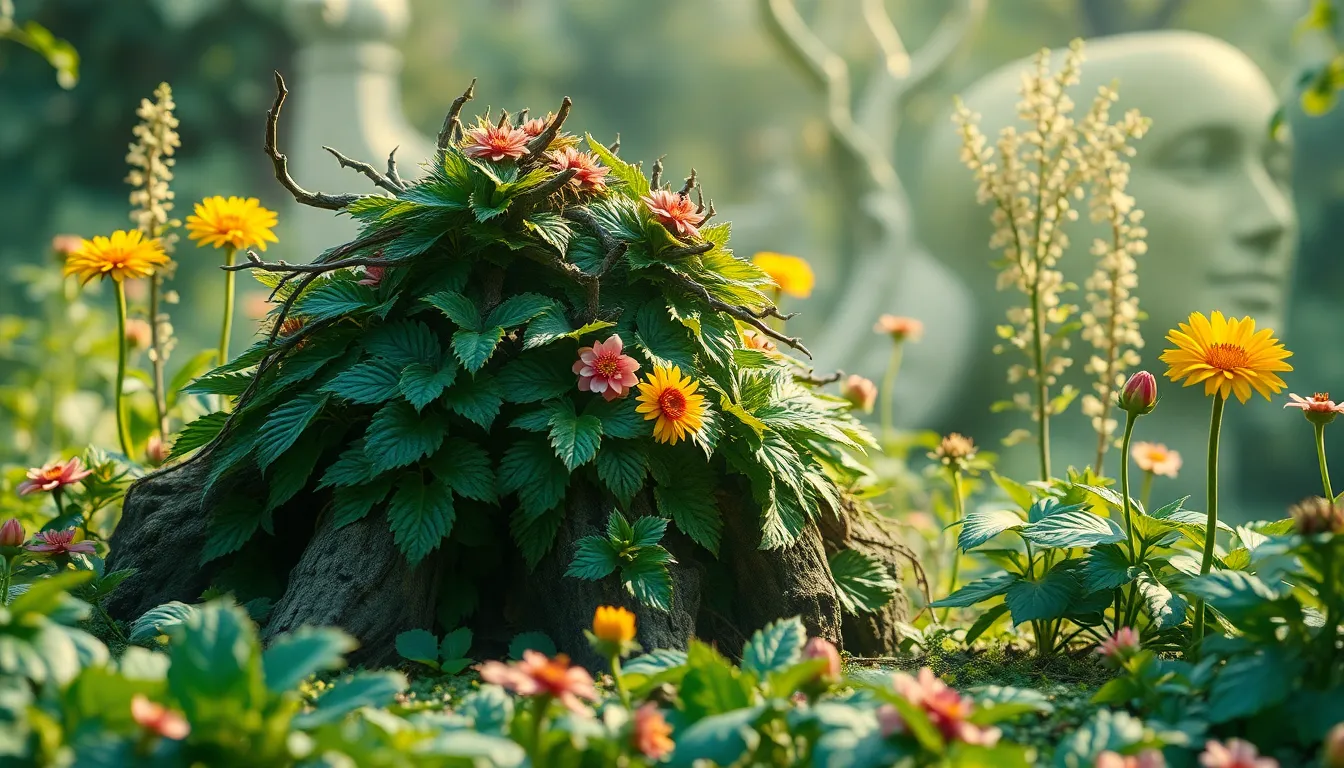The Significance of Nature in Baltic Mythology
For the ancient Balts, nature wasn't just a backdrop to life; it was the very essence of their world. Their mythology, a rich tapestry of stories, beliefs, and rituals, was deeply intertwined with the natural world. From towering forests to rushing rivers, the Balts saw divinity in every element, weaving their beliefs into the very fabric of their existence.
Introduction: The Baltic Worldview and its Connection to Nature
The Balts, who inhabited the lands around the Baltic Sea (modern-day Lithuania, Latvia, and parts of Estonia), possessed a worldview that was intricately connected to the natural world. Unlike many other cultures that saw a separation between the divine and the earthly, the Balts perceived nature as a manifestation of the sacred. Their gods were not distant, abstract entities; they were personified elements of the natural world, embodying the forces that shaped their lives.
The Balts believed in a delicate balance between the visible world and the spiritual realm, and this connection was evident in their rituals, beliefs, and daily practices. They revered the cycles of nature, recognizing the interconnectedness of all living things and the cyclical nature of life, death, and rebirth.
The Divine Realm: Personified Elements and their Roles
In Baltic mythology, the divine domain wasn't a separate realm, but rather an integral part of the natural world. The gods were personifications of natural forces, each representing a specific aspect of life. They were not worshipped as abstract entities, but rather as powerful forces that influenced the world around them.
These deities, often associated with the elements, held significant roles in the lives of the Balts. For example, Perkūnas, the god of thunder and lightning, was a revered protector, while Žemyna, the earth goddess, symbolized fertility and abundance. This close relationship between the divine and the natural world permeated every aspect of Baltic life.
Forests: Sacred Groves, Guardians, and the Realm of the Dead
The forests, with their dense canopies and shrouded paths, held a special significance in Baltic mythology. They were considered sacred spaces, the dwelling places of spirits, gods, and the dead.
Forests were seen as guardians of knowledge and wisdom, and ancient trees were often believed to harbor the souls of ancestors. Sacred groves, where rituals and offerings were performed, were established in these forests. The rustling leaves, the groaning branches, and the whispering wind were believed to be voices of the spirits dwelling within, conveying messages and warnings.
Waters: Sources of Life, Power, and Transformation
Water, in all its forms, was a vital element in Baltic mythology. Rivers, lakes, and the sea were seen as sources of life, power, and transformation. They were believed to hold the essence of the divine, and their waters were often associated with magical properties.
Baltic mythology also recognized the transformative power of water. Ritual bathing in sacred waters was believed to cleanse both body and soul, while the act of crossing a river or the sea symbolized a transition or a journey to a new phase of life.
The Earth Mother: Symbol of Fertility, Abundance, and Creation
The Earth, a source of life and sustenance, held a deeply sacred place in Baltic mythology. It was personified as Žemyna, the Earth Mother, who represented fertility, abundance, and the creative forces of nature. Žemyna was revered as the provider of food, the nurturer of life, and the guardian of all that grows. The Baltic people understood the importance of respecting the Earth and its bounty. They recognized the interconnectedness of all living things and understood that the Earth's well-being was essential for their own survival. This reverence for the Earth Mother was reflected in their agricultural practices, their reverence for the land, and their belief in the cyclical nature of life and death.
The Sun and Moon: Cycles of Life, Time, and Cosmic Power
The sun and moon, celestial bodies that govern the rhythm of life on Earth, held immense significance in Baltic mythology. They were seen as powerful deities, embodying the cycles of life, death, and rebirth, and representing the forces that shape the world. The sun, known as Saulė, was a masculine deity associated with light, warmth, and life-giving energy. He was believed to be a powerful warrior, battling against the forces of darkness and ensuring the cycle of seasons. The moon, Mėnulis, was a feminine deity associated with night, water, and the cycle of growth. She was believed to be a guardian of dreams, a protector of the night, and a symbol of the cyclical nature of time. The Balts celebrated the movements of the sun and moon, marking their positions in the sky with festivals and rituals. These celestial bodies were not just physical objects, but powerful deities whose influence extended to every aspect of life.
Animals: Spirits, Messengers, and Symbols of the Divine
The animal kingdom played a vital role in Baltic mythology, imbued with symbolic meaning and often serving as intermediaries between the human and divine realms. Animals were not simply creatures of nature, but were believed to embody spirits, possess magical powers, and act as messengers for the gods. Birds, with their ability to fly between the earth and the heavens, were seen as messengers of the gods, carrying messages and warnings. Wolves, known for their strength and cunning, were associated with the wild forces of nature and the spirits of the dead. Bears, revered for their power and wisdom, were often considered guardians of the forest and protectors of the natural world. The Balts recognized the connection between humans and animals, understanding that respect for nature and its creatures was essential for maintaining harmony in the world.
Trees: Ancient Wisdom, Guardians of Knowledge, and Sites of Ritual
Trees, particularly ancient ones, were deeply revered in Baltic mythology, symbolizing wisdom, strength, and the connection between the earth and the heavens. Trees were believed to be guardians of knowledge and wisdom, holding secrets passed down through generations. Oak trees, known for their strength and longevity, were often seen as sacred sites and places of worship. They were associated with Perkūnas, the god of thunder and lightning, and were believed to hold his power. Birch trees, with their white bark symbolizing purity, were often associated with fertility and the feminine divine. They were used in rituals and ceremonies, particularly those related to healing and protection. The Balts recognized the importance of respecting trees and their significance in the natural world, understanding that these ancient beings held a vital role in the balance of life.
Thunder and Lightning: Manifestations of Divine Force and Wrath
Thunder and lightning, powerful forces of nature, held a special place in Baltic mythology, often seen as manifestations of the divine and a sign of the gods' presence. Thunder, a deafening roar that shook the earth, was attributed to Perkūnas, the god of thunder and lightning, who wielded his power to protect the world from evil forces and maintain balance. Lightning, a blinding flash of light that split the sky, was seen as a manifestation of Perkūnas's wrath, a reminder of his power and the consequences of displeasing the gods. The Balts revered thunder and lightning, understanding their importance in maintaining the natural order and acknowledging the power and unpredictability of the forces of nature.
Interpretations and Theories: Nature as a Source of Moral and Spiritual Guidance
The deep connection between the Baltic people and their natural world is evident in their mythology, which offers a valuable perspective on their values and worldview. It provides insights into their understanding of the interconnectedness of all living things, the cyclical nature of life and death, and the importance of respecting the natural world. This perspective highlights the importance of nature as a source of moral and spiritual guidance, emphasizing the responsibility humans have to maintain harmony with the world around them. Baltic mythology reminds us to live in balance with nature, recognizing the importance of respecting the Earth, its creatures, and the powerful forces that govern our lives.
FAQ
What is Baltic mythology?
Baltic mythology encompasses the beliefs, myths, and legends of the ancient Baltic people, who inhabited the lands around the Baltic Sea. Their mythology was deeply intertwined with the natural world. They saw divinity in every element, weaving their beliefs into the very fabric of their existence.
What is the significance of nature in Baltic mythology?
Nature was not merely a backdrop to life for the Balts, but the very essence of their world. Their mythology was deeply intertwined with the natural world, reflecting their reverence for the Earth and its bounty. Every element of nature – forests, waters, animals, trees, thunder and lightning – was imbued with symbolic meaning and held a special place in their belief system.
What are some important figures in Baltic mythology?
Some important figures in Baltic mythology include:
- Perkūnas: The god of thunder and lightning, a protector of the world and a symbol of divine power.
- Žemyna: The Earth Mother, symbolizing fertility, abundance, and the creative forces of nature.
- Saulė: The sun god, associated with light, warmth, and life-giving energy.
- Mėnulis: The moon goddess, associated with night, water, and the cycle of growth.
What are some of the key themes in Baltic mythology?
Some key themes in Baltic mythology include:
- The interconnectedness of all living things: The Balts recognized the delicate balance between humanity and the natural world, emphasizing the importance of respecting the Earth and its creatures.
- The cyclical nature of life and death: They believed in the continuous cycle of life, death, and rebirth, reflecting in their reverence for the seasons and their rituals.
- The importance of respecting the natural world: Nature was seen as a source of wisdom, power, and spiritual guidance, underscoring the need for humans to live in harmony with the Earth.
What are some examples of how Baltic mythology reflects the importance of nature?
Baltic mythology offers numerous examples of nature's significance:
- Forests were sacred spaces: They were believed to be the dwelling places of spirits, gods, and the dead, and were revered as guardians of knowledge and wisdom.
- Water was seen as a source of life, power, and transformation: Rivers, lakes, and the sea were associated with magical properties and were central to rituals of cleansing and rebirth.
- Animals were considered to be spirits, messengers, and symbols of the divine: Their behavior and characteristics held special meaning, demonstrating the interconnectedness between the human and animal realms.
- Trees were considered to be guardians of knowledge and wisdom: Ancient trees, especially oaks and birches, were revered as sacred sites and places of worship.
These examples illustrate the profound respect and reverence the ancient Balts held for the natural world, reflecting their deep understanding of its importance in their lives and the spiritual world.



